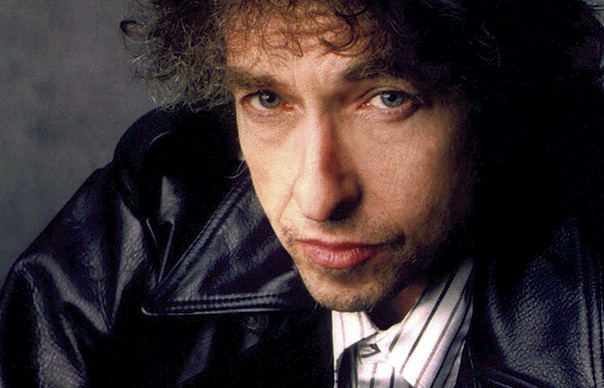TIME OUT OF MIND (1997)
Bob reconvened with Daniel Lanois for album – or should that be round – two. Their collaboration and conflict finds Dylan seeing out the 20th Century with one of his greatest, deepest albums.
Daniel Lanois, producer: “We got together in New York. He just had a stack of lyrics he read me and said: ‘What do you think, Daniel, do we have a record?’ I could hear a record even though I hadn’t heard a note. A lot of philosophical exchanges took place then, about what kind of sound Bob loved.”
Mark Howard, engineer: “Daniel and I shared a workshop in Oxnard, California. Dylan was living in Point Dume. He’d drive up every day, and he’d tune into this radio station he could only get at one point between Point Dume and Oxnard, all these old blues recordings, Little Walter, guys like that. He’d ask, ‘Why do those records sound so great? Can I have that?’ At the same time, Dylan was very interested in Beck. ‘These Beck records are sounding pretty cool.’ So we’d talk about them being loop-based, and playing on top of them. We brought in Tony Mangurian, who’s a hip-hop drummer, his whole thing is computer-based, he loops stuff and builds on top of it. The original idea was we’d do all this cut-and-paste.”
Lanois: “I listened to a lot of old records Bob recommended – Charley Patton, dusty old rock’n’roll, blues. Tony and I played along to those, then I built loops of what we did, and then abandoned these sources; a hip-hop technique. I brought those loops to Bob, and we built demos around them.”
Howard: “We’re all ready to do computer-based stuff, and one day Bob comes in, sits at the piano, and plays this song, ‘Can’t Wait’. And this is a gospel version. Tony starts playing this real sexy groove with him, and Bob is hammering out this gospel piano and really singing. The hair on my arms went up. It was stunning. Luckily, I was recording. We were thinking, if this is going to be anything like this, this record is going to be unbelievable. That’s how it started to drift away from the computer-based thing. Then, just as we’re all set to make the record in Oxnard, Bob says, ‘I can’t work this close to home. I wanna do it in Miami.’ The furthest point away, right? So I threw most of the gear in the truck and I drove from LA to Miami to set up at the Criteria studio.”
David Kemper, drummer: “When we started recording, I remember Bob wouldn’t sing at first, which was strange. And Dan was saying, ‘Don’t play anything you’ve ever played before.’ We cut a version of ‘Mississippi’ and Bob sang, and it sounded good. Then I got a call from Dan, saying, ‘You can’t play pedestrian, we gotta play strange.’ But we got one song, ‘Cold Irons Bound’. The next day I had to leave, and they brought in a whole other crew. That was the end of my involvement. I remember Daniel wasn’t happy [with ‘Cold Irons Bound’]. It was one of his guitar-breaking incidents. He said to Tony [Garnier, bassist] and I: ‘The world doesn’t want another two-note melody from Bob.’ And he smashed a guitar.”
Howard: “There would come a point where there were like 15 people playing in that room at Criteria at the same time. Three drummers, five guitar players, pedal steel, organ, piano… Dan had put together a band, but then Dylan had put out the call for these people like Jim Keltner, Jim Dickinson, Augie Meyers, Duke Robillard, Cindy Cashdollar. Dylan brought in all these Nashville people. I think that made Dan a little mental, all these Nashville strummers.”
Lanois: “I wanted people to respond to the vocal and not play across the vocal, so when the singer sings, you keep quiet. And if you want to respond to the singing, then you should have a signature or a melody and not ramblings. The rambling thing belongs to an old Nashville sound, where people pick a lot. It becomes like a mosquito in the room, like, ‘Would you just stop playing for a minute?’ I want to hear the singer.”
Jim Dickinson, pianist: “Bob had – for want of a better word – an orchestral concept: this thing of too many instruments in the room. There was chordal tension. It’s hard to describe. Dylan was standing singing four feet from the microphone, with no earphones on. He was listening to the sound in the room. Which is the sound that did not go on the record. I truly never saw anything like it. He was in unspoken control of 23 people. And this may seem a small thing, but I was impressed that he had hand-written lyric sheets. He said he’d been working on some of the songs five or six years. He’d lean over this steamer chest and work on his lyrics. With a pencil – because he was erasing stuff. That really touched me to see that.”
Jim Keltner, drummer: “Bob had me and a lot of other guys called specifically. He was thinking about the sound. I think that’s probably the best way to do it: you can either let somebody else get the musicians for you, and then try to figure out how to tell them to do it; or you get the musicians yourself you think can pull off your ideas.”
Augie Meyers, organist: “Bob’s a genius in the studio. He’s a great piano player; a lot of people don’t know that. It amazed me the way he could instantly change keys, hit all the chord changes. No matter what key he went into, he didn’t have to search for the chord.”
Howard: “The way Bob works is, because he hasn’t figured out the song, each take is in a different key. And for the musicians, suddenly you have to change the whole map of the chords. A lot of people can’t just do that straight off. But Dylan kind of expects you to. We’d listen in the control room, though, and it was all over the place – people hitting the wrong note. Dan is saying, ‘Man, this is so chunky.’ Jim Keltner goes: ‘West Coast chunky, or East Coast chunky?’ Things were sort of crazy.”
Dickinson: “Sometimes, when it was all going on, it would be chaotic, for an hour or more. But then there would be this period of clarity, just five or eight minutes of absolute clarity, where everybody knew we were getting it. It was unlike any session I’ve ever been on. Because everybody could feel the potential. In the case of these outtakes that are about to come out, ‘Mississippi’ and ‘Girl From The Red River Shore’ [tracklisted simply as ‘Red River Shore’ on Tell Tale Signs] represented the most conflict in the studio between Dylan and Lanois.”
Keltner: “I have a memory of ‘Red River Shore’ as being just beautiful. I could feel everybody in the room feeling that song. I was disappointed it wasn’t on the album.”
Dickinson: “‘Girl From The Red River Shore’ I personally felt was the best thing we recorded. But as we walked in to hear the playback, Dylan was in front of me, and he said, ‘Well, we’ve done everything on that one except call the symphony orchestra.’ Which indicated to me they’d tried to cut it before. If it had been my session, I would have got on the phone at that point and called the fucking symphony orchestra. But the cut was amazing. You couldn’t even identify what instruments were playing what parts. It sounded like ghost instruments. Then there was a cut of ‘Mississippi’ that was very swampy, a real kind of early ’70s feeling that Lanois really liked. It just wasn’t the direction Dylan wanted to go. The two of them really got into it over that one.”
Meyers: “Bob asked me a couple of questions one time. ‘How would you do this song if you and Doug Sahm did it?’ So I told him. Daniel said, ‘Why are you answering the questions? I’m the producer.’ I just said, ‘Hey, Bob asked me a question, so I’m gonna answer it.’”
Howard: “There was a situation where Bob wouldn’t talk to Dan for a while. Dan would walk in and say, ‘Wow, this is sounding great!’ And Bob would turn to me and say, ‘Did you hear something?’ And I’m sitting there, like ‘Oh, no…’ He was kind of playing, but it was intense.”
Keltner: “There was this dynamic between Bob and Daniel. This may have appeared to some people to be Bob abusing Daniel, but I’d say it was more that he was using Daniel to bounce off. Daniel allowed Bob to know what it was he wanted – and what he didn’t want. I think the reason the recording ended up really beautiful was exactly because of this dynamic. Bob got what he wanted, but he got it through a very intense process.”
Dickinson: “There is for sure something about the recording process that makes Dylan uncomfortable. I think it might have something to do with his history. I think, maybe, some of his stuff he’s been dissatisfied with, and has felt manipulated. I mean, it’s curious to even say the words: that someone could manipulate Bob Dylan. But I saw them try during those sessions. I mean, management would talk to him about the radio. Can you imagine talking to Bob Dylan about getting on the fucking radio? When we finished ‘Highlands’, one of the managers came out, and he said, ‘Well, Bob, have you got a short version of that song?’ Dylan said: ‘That was the short version.’”
Howard: “In terms of the conflict people have mentioned, what those guys were witnessing was – earlier we were talking about that first version of ‘Can’t Wait’ that was so haunting. Dan wanted to get back to that. We’d recorded three other versions. But Dylan wouldn’t go back to the piano, and Dan would say, ‘Y’know, those are good takes, but I just gotta get that version.’ But Dylan wasn’t interested. Dan, for a few days, had this technique where, before Dylan would come in, he’d work up the song himself. Dan would sing it, ‘I can’t wait…’ doing the Dylan voice. And Dylan would walk in to this, and he’d be like, ‘What’s going on here?’ And then Dylan would just shut down. ‘Nah, I’m not recording nothing till you figure this out.’”
Lanois: “Let’s put it this way. When people reach a certain stature, there’s a lot of confidence built around that person, and consequently there’s a lot of people around that think that that person must be right all the time. Unfortunately, it’s not my job to be one of those people.”
Howard: “One of the arguments was this thing about Bob never doing a song the same way twice. Bob pulled Tony Garnier, his regular bass player, into the room with Dan. He says, ‘Tony, have I ever played any song twice exactly the same?’ Tony says, ‘No, Bob, no.’ Bob says, ‘See? I don’t do that.’ And Dan’s like, ‘Yeah, but that song “Can’t Wait”…’ Bob’s like, ‘I did it that way, and I’m never doing it that way again.’ As the end of the session rolled around, though, after recording, we ended up finishing the record back in Oxnard, and by that point, Dan and Dylan were talking again. That’s where all Bob’s storytelling was done, during mixing. He’d talk for two hours at a stretch.”



